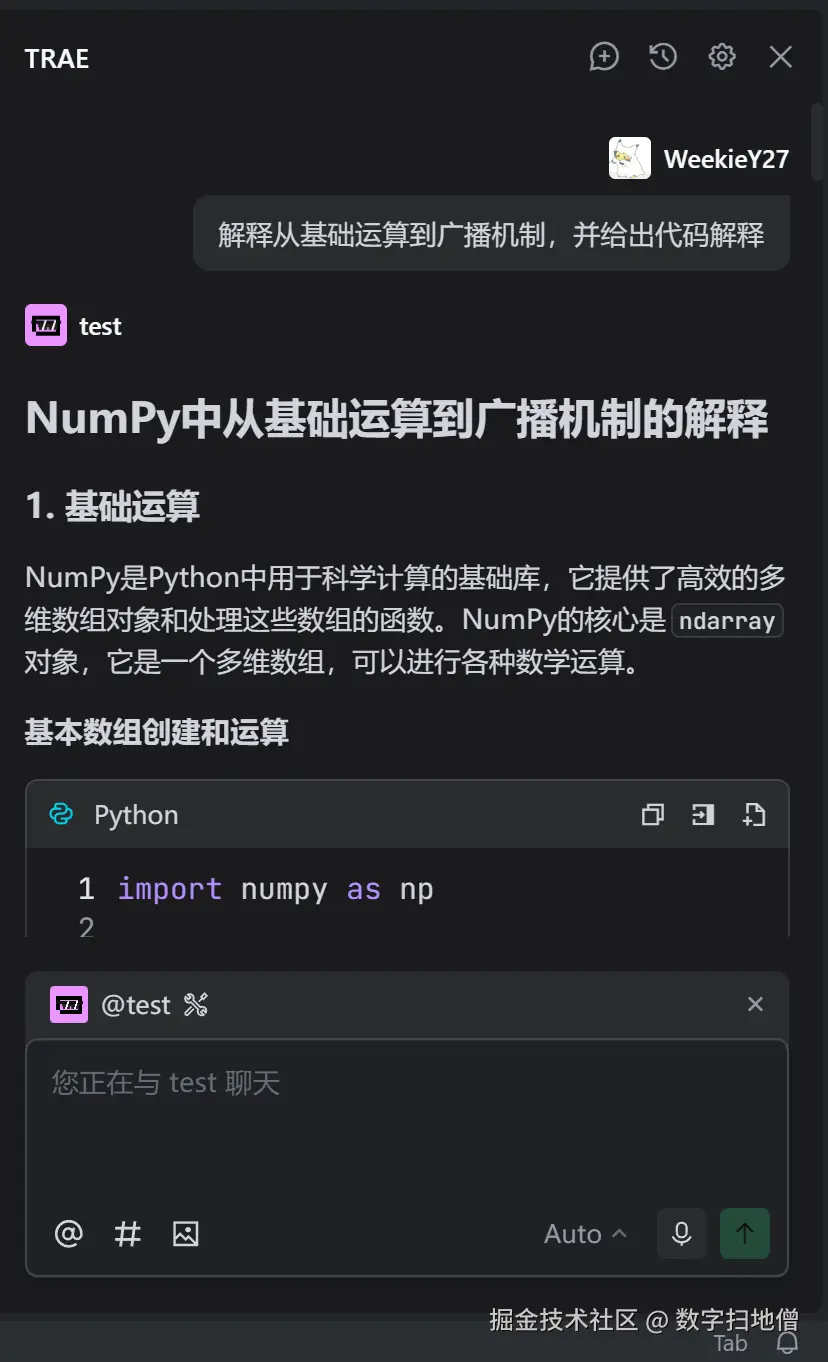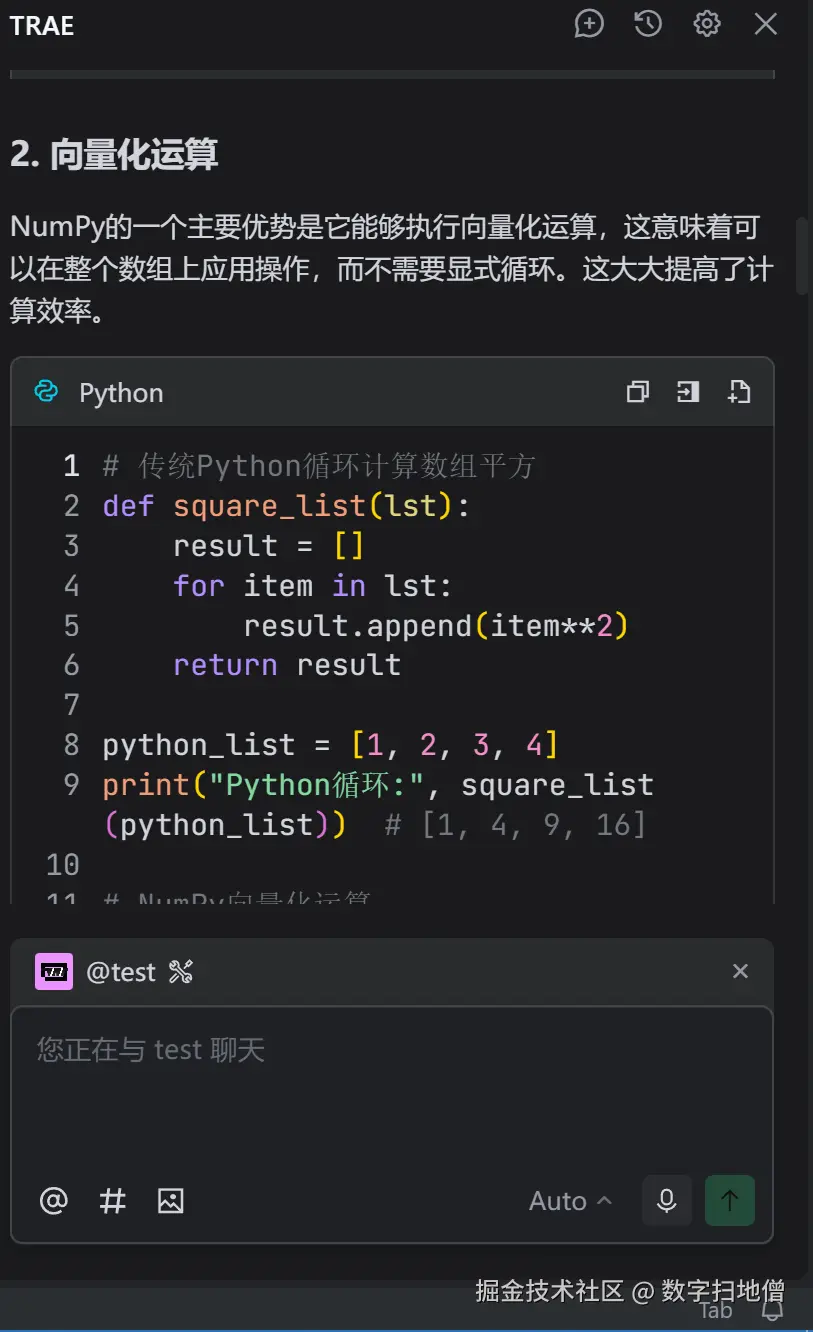一、张量基础概念
1.1 什么是张量?
 张量(Tensor)是深度学习中数据的基本表示形式,可理解为多维数组。它具有以下特点:
张量(Tensor)是深度学习中数据的基本表示形式,可理解为多维数组。它具有以下特点:
- 标量(0 维张量) :单个数值,如
5。 - 向量(1 维张量) :一维数组,如
[1, 2, 3]。 - 矩阵(2 维张量) :二维数组,如
[[1, 2], [3, 4]]。 - 更高维张量 :三维及以上,如
[[[1, 2], [3, 4]], [[5, 6], [7, 8]]]。
张量的维度称为秩(Rank),每个维度的长度称为形状(Shape)。例如,形状为 (3, 4) 的张量是 2 维张量,秩为 2。
| 张量类型 | 维数 | 示例 |
|---|---|---|
| 标量 | 0 | 5 |
| 向量 | 1 | [1, 2, 3] |
| 矩阵 | 2 | [[1, 2], [3, 4]] |
| 3D 张量 | 3 | [ [[1, 2], [3, 4]], [[5, 6], [7, 8]] ] |
1.2 张量的创建
在 Trae 中,使用 tf.constant() 和 tf.Variable() 创建张量。
python
import tensorflow as tf
# 创建标量
scalar = tf.constant(5)
print(f"标量: {scalar}, 类型: {scalar.dtype}, 形状: {scalar.shape}")
# 创建向量
vector = tf.constant([1, 2, 3])
print(f"向量: {vector}, 类型: {vector.dtype}, 形状: {vector.shape}")
# 创建矩阵
matrix = tf.constant([[1, 2], [3, 4]])
print(f"矩阵: {matrix}, 类型: {matrix.dtype}, 形状: {matrix.shape}")
# 创建 3D 张量
tensor_3d = tf.constant([[[1, 2], [3, 4]], [[5, 6], [7, 8]]])
print(f"3D 张量: {tensor_3d}, 类型: {tensor_3d.dtype}, 形状: {tensor_3d.shape}")代码解释:
tf.constant():创建不可变张量,默认为int32类型。scalar:标量,形状为空(())。vector:向量,形状为(3,)。matrix:矩阵,形状为(2, 2)。tensor_3d:3D 张量,形状为(2, 2, 2)。
1.3 张量的属性
张量具有以下重要属性:
- dtype :数据类型,如
int32、float32等。 - shape:张量形状,表示各维度的大小。
- ndim:张量的维度数(秩)。
python
# 查看张量属性
print(f"张量类型: {matrix.dtype}")
print(f"张量形状: {matrix.shape}")
print(f"张量维度数: {matrix.ndim}")输出示例:
makefile
张量类型: tf.int32
张量形状: (2, 2)
张量维度数: 21.4 张量基础概念总结(使用 mermaid 绘制思维导图)

二、张量基础运算
2.1 张量的算术运算
张量支持基本的算术运算,包括加法、减法、乘法和除法。
python
# 张量算术运算
a = tf.constant([1, 2, 3])
b = tf.constant([4, 5, 6])
# 加法
add_result = tf.add(a, b) # 或 a + b
print(f"加法结果: {add_result}")
# 减法
sub_result = tf.subtract(a, b) # 或 a - b
print(f"减法结果: {sub_result}")
# 乘法
mul_result = tf.multiply(a, b) # 或 a * b(元素级乘法)
print(f"乘法结果: {mul_result}")
# 除法
div_result = tf.divide(a, b) # 或 a / b
print(f"除法结果: {div_result}")代码解释:
tf.add():张量加法,对应元素相加。tf.subtract():张量减法,对应元素相减。tf.multiply():元素级乘法(不是矩阵乘法)。tf.divide():元素级除法。
输出示例:
ini
加法结果: tf.Tensor([5 7 9], shape=(3,), dtype=int32)
减法结果: tf.Tensor([-3 -3 -3], shape=(3,), dtype=int32)
乘法结果: tf.Tensor([4 10 18], shape=(3,), dtype=int32)
除法结果: tf.Tensor([0.25 0.4 0.5 ], shape=(3,), dtype=float64)2.2 张量的矩阵运算
矩阵运算包括矩阵乘法、转置和求逆等。
python
# 矩阵运算
matrix1 = tf.constant([[1, 2], [3, 4]], dtype=tf.float32)
matrix2 = tf.constant([[5, 6], [7, 8]], dtype=tf.float32)
# 矩阵乘法
matmul_result = tf.matmul(matrix1, matrix2) # 或 matrix1 @ matrix2
print(f"矩阵乘法结果:\n{matmul_result}")
# 矩阵转置
transpose_result = tf.transpose(matrix1)
print(f"矩阵转置结果:\n{transpose_result}")
# 矩阵求逆(仅适用于可逆矩阵)
inverse_result = tf.linalg.inv(matrix1)
print(f"矩阵求逆结果:\n{inverse_result}")代码解释:
tf.matmul():矩阵乘法,计算两个矩阵的乘积。tf.transpose():矩阵转置,交换矩阵的行和列。tf.linalg.inv():矩阵求逆,仅适用于方阵且行列式不为零。
输出示例:
lua
矩阵乘法结果:
tf.Tensor(
[[19. 22.]
[43. 50.]], shape=(2, 2), dtype=float32)
矩阵转置结果:
tf.Tensor(
[[1. 3.]
[2. 4.]], shape=(2, 2), dtype=float32)
矩阵求逆结果:
tf.Tensor(
[[-2. 1. ]
[ 1.5 -0.5]], shape=(2, 2), dtype=float32)2.3 张量的逻辑运算
张量支持逻辑运算,如比较运算和布尔运算。
python
# 逻辑运算
a = tf.constant([1, 2, 3])
b = tf.constant([2, 2, 2])
# 大于比较
greater_result = tf.greater(a, b) # 或 a > b
print(f"大于比较结果: {greater_result}")
# 小于比较
less_result = tf.less(a, b) # 或 a < b
print(f"小于比较结果: {less_result}")
# 布尔运算(按位与、或、非)
bool_a = tf.constant([True, False, True])
bool_b = tf.constant([False, True, True])
and_result = tf.logical_and(bool_a, bool_b) # 或 bool_a & bool_b
or_result = tf.logical_or(bool_a, bool_b) # 或 bool_a | bool_b
not_result = tf.logical_not(bool_a) # 或 ~bool_a代码解释:
tf.greater():比较两个张量,返回布尔张量,表示对应元素是否满足大于关系。tf.less():比较两个张量,返回布尔张量,表示对应元素是否满足小于关系。tf.logical_and():布尔按位与运算。tf.logical_or():布尔按位或运算。tf.logical_not():布尔按位非运算。
输出示例:
python
大于比较结果: tf.Tensor([False False True], shape=(3,), dtype=bool)
小于比较结果: tf.Tensor([ True False False], shape=(3,), dtype=bool)2.4 张量基础运算总结(使用 mermaid 绘制流程图)
三、张量索引与切片
3.1 张量索引
张量索引与 Python 列表索引类似,用于访问张量中的单个元素。
python
# 张量索引
tensor = tf.constant([1, 2, 3, 4, 5])
# 访问第一个元素
first_element = tensor[0]
print(f"第一个元素: {first_element}")
# 访问最后一个元素
last_element = tensor[-1]
print(f"最后一个元素: {last_element}")
# 访问指定位置元素
element = tensor[2]
print(f"第三个元素: {element}")代码解释:
tensor[0]:访问索引为 0 的元素(第一个元素)。tensor[-1]:访问最后一个元素。
输出示例:
ini
第一个元素: tf.Tensor(1, shape=(), dtype=int32)
最后一个元素: tf.Tensor(5, shape=(), dtype=int32)
第三个元素: tf.Tensor(3, shape=(), dtype=int32)3.2 张量切片
张量切片用于获取张量中的一部分元素,语法为 tensor[start:end:step]。
python
# 张量切片
tensor = tf.constant([1, 2, 3, 4, 5, 6])
# 获取前 3 个元素
first_three = tensor[:3]
print(f"前 3 个元素: {first_three}")
# 获取从索引 2 到索引 5 的元素
middle_elements = tensor[2:5]
print(f"中间元素: {middle_elements}")
# 获取所有偶数索引的元素
even_indices = tensor[::2]
print(f"偶数索引元素: {even_indices}")
# 获取所有奇数索引的元素
odd_indices = tensor[1::2]
print(f"奇数索引元素: {odd_indices}")代码解释:
tensor[:3]:从索引 0 到 2(不包含 3),即前 3 个元素。tensor[2:5]:从索引 2 到 4(不包含 5)。tensor[::2]:步长为 2,获取所有偶数索引的元素。tensor[1::2]:从索引 1 开始,步长为 2,获取所有奇数索引的元素。
输出示例:
ini
前 3 个元素: tf.Tensor([1 2 3], shape=(3,), dtype=int32)
中间元素: tf.Tensor([3 4 5], shape=(3,), dtype=int32)
偶数索引元素: tf.Tensor([1 3 5], shape=(3,), dtype=int32)
奇数索引元素: tf.Tensor([2 4 6], shape=(3,), dtype=int32)3.3 多维张量索引与切片
对于多维张量,索引和切片操作可以扩展到多个维度。
python
# 多维张量索引与切片
matrix = tf.constant([[1, 2, 3], [4, 5, 6], [7, 8, 9]])
# 访问第二行第三列元素
element = matrix[1, 2]
print(f"第二行第三列元素: {element}")
# 获取第一行所有列
first_row = matrix[0, :]
print(f"第一行所有列: {first_row}")
# 获取所有行的第二列
second_column = matrix[:, 1]
print(f"所有行的第二列: {second_column}")
# 获取子矩阵(前两行,后两列)
sub_matrix = matrix[:2, 1:]
print(f"子矩阵:\n{sub_matrix}")代码解释:
matrix[1, 2]:访问第二行(索引为 1)第三列(索引为 2)的元素。matrix[0, :]:获取第一行(索引为 0)的所有列。matrix[:, 1]:获取所有行的第二列(索引为 1)。matrix[:2, 1:]:获取前两行(索引 0 和 1),从第二列开始到最后一列。
输出示例:
ini
第二行第三列元素: tf.Tensor(6, shape=(), dtype=int32)
第一行所有列: tf.Tensor([1 2 3], shape=(3,), dtype=int32)
所有行的第二列: tf.Tensor([2 5 8], shape=(3,), dtype=int32)
子矩阵:
tf.Tensor(
[[2 3]
[5 6]], shape=(2, 2), dtype=int32)3.4 张量索引与切片总结(使用 mermaid 绘制思维导图)
四、张量形状变换
4.1 改变张量形状
通过 tf.reshape() 改变张量的形状,但需保持元素总数不变。
python
# 改变张量形状
tensor = tf.constant([1, 2, 3, 4, 5, 6])
# 改变形状为 (2, 3)
reshaped_tensor = tf.reshape(tensor, (2, 3))
print(f"改变形状为 (2, 3):\n{reshaped_tensor}")
# 改变形状为 (3, 2)
reshaped_tensor = tf.reshape(tensor, (3, 2))
print(f"改变形状为 (3, 2):\n{reshaped_tensor}")
# 使用 -1 自动计算维度
reshaped_tensor = tf.reshape(tensor, (2, -1))
print(f"使用 -1 自动计算维度:\n{reshaped_tensor}")代码解释:
tf.reshape(tensor, shape):将张量改变为指定形状。- 形状参数中可以使用
-1,表示自动计算该维度的大小。
输出示例:
lua
改变形状为 (2, 3):
tf.Tensor(
[[1 2 3]
[4 5 6]], shape=(2, 3), dtype=int32)
改变形状为 (3, 2):
tf.Tensor(
[[1 2]
[3 4]
[5 6]], shape=(3, 2), dtype=int32)
使用 -1 自动计算维度:
tf.Tensor(
[[1 2 3]
[4 5 6]], shape=(2, 3), dtype=int32)4.2 张量的拼接
将多个张量沿着指定轴拼接在一起。
python
# 张量拼接
tensor1 = tf.constant([[1, 2], [3, 4]])
tensor2 = tf.constant([[5, 6], [7, 8]])
# 沿行拼接(轴=0)
concat_row = tf.concat([tensor1, tensor2], axis=0)
print(f"沿行拼接:\n{concat_row}")
# 沿列拼接(轴=1)
concat_col = tf.concat([tensor1, tensor2], axis=1)
print(f"沿列拼接:\n{concat_col}")代码解释:
tf.concat([tensor1, tensor2], axis):沿指定轴拼接张量。axis=0:沿行拼接,增加行数。axis=1:沿列拼接,增加列数。
输出示例:
ini
沿行拼接:
tf.Tensor(
[[1 2]
[3 4]
[5 6]
[7 8]], shape=(4, 2), dtype=int32)
沿列拼接:
tf.Tensor(
[[1 2 5 6]
[3 4 7 8]], shape=(2, 4), dtype=int32)4.3 张量的堆叠
将多个张量沿着新轴堆叠在一起。
python
# 张量堆叠
tensor1 = tf.constant([1, 2, 3])
tensor2 = tf.constant([4, 5, 6])
# 沿新轴堆叠(轴=0)
stacked_tensor = tf.stack([tensor1, tensor2], axis=0)
print(f"沿新轴堆叠 (轴=0):\n{stacked_tensor}")
# 沿新轴堆叠(轴=1)
stacked_tensor = tf.stack([tensor1, tensor2], axis=1)
print(f"沿新轴堆叠 (轴=1):\n{stacked_tensor}")代码解释:
tf.stack([tensor1, tensor2], axis):沿指定新轴堆叠张量。axis=0:在第一个维度前插入新轴。axis=1:在第二个维度前插入新轴。
输出示例:
lua
沿新轴堆叠 (轴=0):
tf.Tensor(
[[1 2 3]
[4 5 6]], shape=(2, 3), dtype=int32)
沿新轴堆叠 (轴=1):
tf.Tensor(
[[1 4]
[2 5]
[3 6]], shape=(3, 2), dtype=int32)4.4 张量的展开与挤压
展开和挤压张量的维度。
python
# 展开张量维度
tensor = tf.constant([[1, 2, 3]])
# 在第 0 轴展开
expanded_tensor = tf.expand_dims(tensor, axis=0)
print(f"在第 0 轴展开:\n{expanded_tensor}")
# 在第 1 轴展开
expanded_tensor = tf.expand_dims(tensor, axis=1)
print(f"在第 1 轴展开:\n{expanded_tensor}")
# 挤压张量维度
tensor = tf.constant([[[1], [2], [3]]])
# 挤压维度为 1 的轴
squeezed_tensor = tf.squeeze(tensor, axis=1)
print(f"挤压第 1 轴后的张量:\n{squeezed_tensor}")代码解释:
tf.expand_dims(tensor, axis):在指定位置插入一个维度为 1 的轴。tf.squeeze(tensor, axis):移除指定的维度为 1 的轴。
输出示例:
lua
在第 0 轴展开:
tf.Tensor(
[[[1 2 3]]], shape=(1, 1, 3), dtype=int32)
在第 1 轴展开:
tf.Tensor(
[[[1]
[2]
[3]]], shape=(1, 3, 1), dtype=int32)
挤压第 1 轴后的张量:
tf.Tensor(
[[1]
[2]
[3]], shape=(1, 3), dtype=int32)4.5 张量形状变换总结(使用 mermaid 绘制流程图)
五、广播机制详解
5.1 什么是广播机制?
广播机制(Broadcasting)允许形状不同的张量进行运算,通过自动扩展形状较小的张量来匹配形状较大的张量。
广播规则:
- 对齐维度:将两个张量的形状从右向左对齐。
- 维度匹配 :
- 如果某一维度的大小相等,则可以广播。
- 如果某一维度的大小为 1,则可以沿该维度广播。
- 如果某一维度的大小不为 1 且不相等,则无法广播,会抛出错误。
5.2 广播机制实例分析
5.2.1 标量与向量广播
标量与向量进行运算时,标量会被广播到与向量相同的形状。
python
# 标量与向量广播
vector = tf.constant([1, 2, 3])
scalar = tf.constant(2)
# 标量与向量加法
result = vector + scalar
print(f"标量与向量加法结果: {result}")代码解释:
- 标量
2被广播为向量[2, 2, 2],然后与原向量[1, 2, 3]相加。
输出示例:
ini
标量与向量加法结果: tf.Tensor([3 4 5], shape=(3,), dtype=int32)5.2.2 向量与矩阵广播
向量与矩阵进行运算时,向量会被广播以匹配矩阵的形状。
python
# 向量与矩阵广播
matrix = tf.constant([[1, 2, 3], [4, 5, 6]])
vector = tf.constant([1, 0, 1])
# 向量与矩阵加法
result = matrix + vector
print(f"向量与矩阵加法结果:\n{result}")代码解释:
- 向量
[1, 0, 1]被广播为与矩阵相同的形状(2, 3),然后逐元素相加。
输出示例:
lua
向量与矩阵加法结果:
tf.Tensor(
[[2 2 4]
[5 5 7]], shape=(2, 3), dtype=int32)5.2.3 矩阵与矩阵广播
两个矩阵进行运算时,若形状不完全相同但满足广播条件,则会广播到兼容的形状。
python
# 矩阵与矩阵广播
matrix1 = tf.constant([[1, 2], [3, 4]])
matrix2 = tf.constant([[1], [2]])
# 矩阵加法
result = matrix1 + matrix2
print(f"矩阵加法结果:\n{result}")代码解释:
- 矩阵
matrix2的形状为(2, 1),在第二维度(列)被广播为(2, 2),然后与matrix1相加。
输出示例:
lua
矩阵加法结果:
tf.Tensor(
[[2 3]
[5 6]], shape=(2, 2), dtype=int32)5.3 广播机制总结(使用 mermaid 绘制思维导图)
六、实战案例分析
6.1 数据预处理:标准化与归一化
在机器学习和深度学习中,数据预处理是重要步骤。张量操作可用于实现数据的标准化和归一化。
python
# 数据预处理:标准化与归一化
import tensorflow as tf
# 生成随机数据
data = tf.random.normal([100, 5], mean=0, stddev=1.0)
# 标准化:将数据转换为均值为 0,标准差为 1
mean = tf.reduce_mean(data, axis=0)
std = tf.math.reduce_std(data, axis=0)
standardized_data = (data - mean) / std
# 归一化:将数据缩放到 [0, 1] 范围
min_val = tf.reduce_min(data, axis=0)
max_val = tf.reduce_max(data, axis=0)
normalized_data = (data - min_val) / (max_val - min_val)代码解释:
tf.reduce_mean(data, axis=0):计算每列的均值。tf.math.reduce_std(data, axis=0):计算每列的标准差。tf.reduce_min(data, axis=0)和tf.reduce_max(data, axis=0):计算每列的最小值和最大值。- 标准化公式:
(data - mean) / std - 归一化公式:
(data - min) / (max - min)
6.2 图像数据操作:调整大小与归一化
在图像处理任务中,张量操作可用于调整图像大小和归一化像素值。
python
# 图像数据操作:调整大小与归一化
import tensorflow as tf
# 加载图像数据(假设为 28x28x3 的图像)
image = tf.random.uniform([28, 28, 3], minval=0, maxval=255, dtype=tf.int32)
# 调整图像大小为 64x64x3
resized_image = tf.image.resize(image, [64, 64])
# 归一化像素值到 [0, 1]
normalized_image = tf.cast(resized_image, tf.float32) / 255.0代码解释:
tf.image.resize(image, [64, 64]):调整图像大小。tf.cast(resized_image, tf.float32):将图像数据类型转换为float32。- 归一化:将像素值除以 255,使其范围变为
[0, 1]。
6.3 自定义损失函数与梯度计算
在深度学习模型训练中,张量操作可用于构建自定义损失函数并计算梯度。
python
# 自定义损失函数与梯度计算
import tensorflow as tf
# 定义模型参数
weights = tf.Variable([1.0, 2.0], dtype=tf.float32)
bias = tf.Variable(0.0, dtype=tf.float32)
# 定义输入和目标输出
inputs = tf.constant([[1.0, 2.0], [3.0, 4.0]], dtype=tf.float32)
targets = tf.constant([3.0, 7.0], dtype=tf.float32)
# 定义前向传播
def forward_pass(inputs):
return tf.reduce_sum(inputs * weights) + bias
# 定义自定义损失函数
def custom_loss(y_true, y_pred):
return tf.reduce_mean(tf.square(y_true - y_pred)) # 均方误差
# 计算前向传播结果
with tf.GradientTape() as tape:
predictions = forward_pass(inputs)
loss = custom_loss(targets, predictions)
# 计算梯度
gradients = tape.gradient(loss, [weights, bias])
# 更新模型参数(简单梯度下降)
learning_rate = 0.01
weights.assign_sub(learning_rate * gradients[0])
bias.assign_sub(learning_rate * gradients[1])
print(f"更新后的权重: {weights.numpy()}")
print(f"更新后的偏置: {bias.numpy()}")代码解释:
tf.GradientTape():记录张量操作以自动计算梯度。tape.gradient(loss, [weights, bias]):计算损失对参数的梯度。assign_sub():将梯度乘以学习率后从参数中减去,实现梯度下降更新。